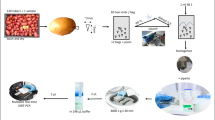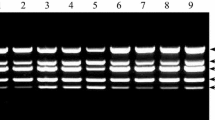Abstract
RNA viruses have a great potential for high genetic variability and rapid evolution that is generated by mutation and recombination under selection pressure. This is also the case of Potato virus Y (PVY), which comprises a high diversity of different recombinant and non-recombinant strains. Consequently, it is hard to develop reverse transcription real-time quantitative PCR (RT-qPCR) with the same amplification efficiencies for all PVY strains which would enable their equilibrate quantification; this is specially needed in mixed infections and other studies of pathogenesis. To achieve this, we initially transferred the PVY universal RT-qPCR assay to a reverse transcription droplet digital PCR (RT-ddPCR) format. RT-ddPCR is an absolute quantification method, where a calibration curve is not needed, and it is less prone to inhibitors. The RT-ddPCR developed and validated in this study achieved a dynamic range of quantification over five orders of magnitude, and in terms of its sensitivity, it was comparable to, or even better than, RT-qPCR. RT-ddPCR showed lower measurement variability. We have shown that RT-ddPCR can be used as a reference tool for the evaluation of different RT-qPCR assays. In addition, it can be used for quantification of RNA based on in-house reference materials that can then be used as calibrators in diagnostic laboratories.






Similar content being viewed by others
References
Kogovšek P, Kladnik A, Mlakar J, Tušek Žnidarič M, Dermastia M, Ravnikar M, et al. Distribution of potato virus Y in potato plant organs, tissues, and cells. Phytopathology. 2011;101:1292–300.
Dobnik D, Baebler Š, Kogovšek P, Pompe Novak M, Štebih D, Panter G, et al. [Beta]-1,3-glucanase class III promotes spread of PVYNTN and improves in planta protein production. Plant Biotechnol Rep. 2013;7(4):547–55.
Gutiérrez-Aguirre I, Rački N, Dreo T, Ravnikar M. Droplet digital PCR for absolute quantification of pathogens. In: Lacomme C, editor. Plant pathology: techniques and protocols. Methods in Molecular Biology. vol. 1302. New York: Springer Science+Business Media; 2015. p. 331–47.
Bujarsk JJ. Molecular basis of genetic variability in RNA viruses. In: Mandahar CL, editor. Molecular biology of plant viruses. Boston: Springer; 1999. p. 121–41.
Cankar K, Štebih D, Dreo T, Žel J, Gruden K. Critical points of DNA quantification by real-time PCR—effects of DNA extraction method and sample matrix on quantification of genetically modified organisms. BMC Biotechnol. 2006;6:37.
Sedlak RH, Jerome KR. Viral diagnostics in the era of digital polymerase chain reaction. Diagn Microbiol Infect Dis. 2013;75:1–4.
Dube S, Qin J, Ramakrishnan R. Mathematical analysis of copy number variation in a DNA sample using digital PCR on a nanofluidic device. PLoS One. 2008;3:e2876.
Pekin D, Skhiri Y, Baret JC, Le Corre D, Mazutis L, Salem CB, et al. Quantitative and sensitive detection of rare mutations using droplet-based microfluidics. Lab Chip. 2011;11:2156–66.
Hindson CM, Chevillet JR, Briggs HA, Gallichotte EN, Ruf IK, Hindson BJ, et al. Absolute quantification by droplet digital PCR versus analog real-time PCR. Nat Methods. 2013;10:1003–5.
Morisset D, Štebih D, Milavec M, Gruden K, Žel J. Quantitative analysis of food and feed samples with droplet digital PCR. PLoS One. 2013;8(5):e62583.
Dreo T, Pirc M, Ramšak Ž, Pavšič J, Milavec M, Žel J, et al. Optimising droplet digital PCR analysis approaches for detection and quantification of bacteria: a case study of fire blight and potato brown rot. Anal Bioanal Chem. 2014;406:6513–28.
Mehle N, Dreo T, Ravnikar M. Quantitavie analysis of flavescence doreé phytoplasma with droplet digital PCR. Phytopathogenic Mollicutes. 2014;4(1):9–15.
Rački N, Dreo T, Gutierrez-Aguirre I, Blejec A, Ravnikar M. Reverse transcriptase droplet digital PCR shows high resilience to PCR inhibitors from plant, soil and water samples. Plant Methods. 2014;10(1):42.
Rački N, Morisset D, Gutierrez-Aguirre I, Ravnikar M. One-step RT-droplet digital PCR: a breakthrough in the quantification of waterborne RNA viruses. Anal Bianal Chem. 2014;406(3):661–7.
Scholthof KB, Adkins S, Czosnek H, Palukaitis P, Jacquot E, Hohn T, et al. Top 10 plant viruses in molecular plant pathology. Mol Plant Pathol. 2011;12:938–54.
Nault LR. Arthropod transmission of plant viruses: a new synthesis. Ann Entomol Soc Am. 1997;90:521–41.
Mehle N, Gutierrez-Aguirre I, Prezelj N, Delić D, Vidic U, Ravnikar M. Survival and transmission of potato virus Y, Pepino mosaic virus, and potato spindle tuber viroid in water. Appl Environ Microbiol. 2014;80(4):1455–62.
Glais L, Chikh Ali M, Karasev AV, Kutnjak D, Lacomme C. Detection and diagnosis of PVY. In: Lacomme C, Glais L, Bellstedt D, Dupuis B, Karasev AV, Jacquot E, editors. Potato virus Y—biodiversity, pathogenicity, epidemiology and management. Cham: Springer; 2017. p. 103–39.
Kogovšek P, Gow L, Pompe Novak M, Gruden K, Foster GD, Boonham N, et al. Single-step RT real-time PCR for sensitive detection and discrimination of potato virus Y isolates. J Virol Methods. 2008;149(1):1–11.
Pfaffl MW. A new mathematical model for relative quantification in real-time RT-PCR. Nucleic Acids Res. 2001;29:e45.
Gutiérrez-Aguirre I, Mehle N, Delić D, Gruden K, Mumford R, Ravnikar M. Real-time quantitative PCR based sensitive detection and genotype discrimination of Pepino mosaic virus. J Virol Methods. 2009;162:46–55.
Lenarčič R, Morisset D, Mehle N, Ravnikar M. Fast real-time detection of Potato spindle tuber viroid by RT-LAMP. Plant Pathol. 2013;62(5):1147–56.
Bustin SA. Absolute quantification of mRNA using real-time reverse transcription polymerase chain reaction assays. J Mol Endocrinol. 2000;25:169–93.
European and Mediterranean Plant Protection Organisation. Specific requirements for laboratories preparing accreditation for a plant pest diagnostic activity PM7/98 (2). EPPO Bull. 2014;44:117–47.
Deprez L, Corbisier P, Kortekaas A-M, Mazoua S, Hidalgo RB, Trapmann S, et al. Validation of digital PCR method for quantification of DNA copy number concentrations by using a certified reference material. Biomol Detect Quantific. 2016;9:29–39.
Huggett JF, Foy CA, Benes V, Emslie K, Garson JA, Haynes R, et al. Guidelines for minimum information for publication of quantitative digital PCR experiments. Clin Chem. 2013;59(6):892–902.
Lievens A, Jacchia S, Kagkli D, Savini C, Querci M. Measuring digital PCR quality: performance parameters and their optimization. PLoS One. 2016;11(5):e0153317.
Baker M. Digital PCR hits its stride. Nat Methods. 2012;9(6):541–4.
Acknowledgements
This study was supported by the Slovenian Research Agency (grant number P4-0165) and by Euphresco Project VirusCollectII (2015-F-132), financed by the Ministry of Agriculture, Forestry and Food through the Administration of the Republic of Slovenia for Food Safety, Veterinary and Plant Protection. The study was performed using ddPCR equipment financed by the Metrology Institute of the Republic of Slovenia (MIRS), with financial support from the European Regional Development Fund. The equipment is wholly owned by the Republic of Slovenia. We would like to thank Bio-Rad Laboratories, Inc. for providing the RT-ddPCR reagents. We would like to thank INRA, France, for providing the PVY-O139 and PVY-N605 isolates. We also thank Vildan Bolat (student at Nigde University, Turkey, on a collaboration through an ERASMUS internship) for technical help. The scientific language revision was carried out by Dr. Christopher Berrie.
Author information
Authors and Affiliations
Corresponding author
Ethics declarations
Conflict of interest
The authors declare the following competing financial interest: the reagents for this study were provided by Bio-Rad, which sells and markets the QX100/200 droplet digital PCR system. The authors declare that they have no other conflict of interest.
Electronic supplementary material
ESM 1
(PDF 224 kb)
Rights and permissions
About this article
Cite this article
Mehle, N., Dobnik, D., Ravnikar, M. et al. Validated reverse transcription droplet digital PCR serves as a higher order method for absolute quantification of Potato virus Y strains. Anal Bioanal Chem 410, 3815–3825 (2018). https://doi.org/10.1007/s00216-018-1053-3
Received:
Revised:
Accepted:
Published:
Issue Date:
DOI: https://doi.org/10.1007/s00216-018-1053-3




